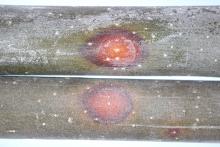See:
Apple (Malus spp.) - Anthracnose (Bull's-eye Rot)
Cause The fungus Phlyctema vagabunda. This ash disease has been found on nursery stock in Michigan, Oregon, and Ontario, Canada. It was found in Montana in 2010 on ash nursery stock brought from Idaho. Field grown stock is generally not affected unless it is harvested and potted for later growth and sale. Cultivars that have been observed with symptoms include Cimmaron, ChampTree, Urbanite, and Autumn Purple.
A few other stem cankers caused by fungi have been found by the OSU Plant Clinic including Cytospora sp., Fusarium lateritium, Phomopsis sp. and a Botyosphaeria sp.
Symptoms Coin cankers occur on the main stem or trunk of trees. These cankers are smooth, round, brownish yellow, and range in size from 0.5 to 1.5 inches in diameter. On smaller trees cankers will grow together to make a blotchy appearance. The margins on larger cankers are distinctly reddish and have cracked margins. Cankers are annual and will not individually girdle a tree. Once they coalesce and increase in number, the damage can have a serious impact on trees.
Cultural control
- Minimize wounding during harvest of nursery stock.
- Remove nearby apple trees with visible cankers.
- Remove and destroy diseased trees.
Chemical control None have been investigated; however, applications prior to fall rains and/or digging (timings that help control apple anthracnose) may be helpful.
References Rossman, A.Y., Castlebury, L.A., Adams, G.C., and Putnam, M.L. 2002. Phlyctema vagabunda isolated from coin canker of ash trees in Michigan. Plant Disease 86:442. http://dx.doi.org/10.1094/PDIS.2002.86.4.442A
Putnam, M.L. and Adams, G.C. 2005. Phlyctema vagabunda causes coin canker of ash (Fraxinus spp.) in North America. Plant Disease 89:773. http://dx.doi.org/10.1094/PD-89-0773B


